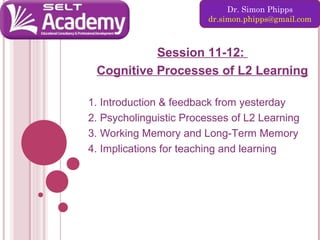
CTS-Academic: Module 2 session 9 cognitive processes
- 1. Dr. Simon Phipps dr.simon.phipps@gmail.com Session 11-12: Cognitive Processes of L2 Learning 1. Introduction & feedback from yesterday 2. Psycholinguistic Processes of L2 Learning 3. Working Memory and Long-Term Memory 4. Implications for teaching and learning
- 2. PSYCHOLINGUISTIC PROCESSES OF LEARNING Human beings are limited in their capacity to consciously attend to more than one task at a time Memory speed Memory is unlimited Processing capacity is limited we cannot attend to all language some language is automatic otherwise we could not operate in real time fluency = when language becomes automatic = we know which word is going to come next
- 3. PSYCHOLINGUISTIC PROCESSES OF LEARNING Dual-coding system Rule based system R E Rules Most language we use is not new Exemplar-based system Examples of language • Individual words • Chunks of language we use rules only when we need to, as most language we use is automatic Working memory vs LTM the more we use language, the more automatic it becomes the more automatic it becomes, the less we need to consciously think of rules L2 learners typically need the rule system more; because they don’t have enough exemplars stored so, they are less fluent from Skehan, P. (1998). A Cognitive Approach to Language Learning. Cambridge: OUP.
- 4. PSYCHOLINGUISTIC PROCESSES OF LEARNING Stages of processing; Input processing Central processing Output processing noticing restructuring proceduralisation
- 5. INPUT PROCESSING MODEL FOR LANGUAGE more input input lost input processing noticing noticing the gap renoticing central processing intake restructuring forgotten recall & rehearsal output processing use proceduralisation
- 6. INPUT PROCESSING 1 Importance of attention Noticing (Schmidt) frequency importance instruction processing ability readiness to notice task demands Implicit vs Explicit Learning noticing by the learner noticing for the learner Consciousness attention awareness control
- 7. INPUT PROCESSING 2 Noticing is influenced by; - input - existing knowledge systems - processing capacities Meaning takes precedence over form can only attend to form if resources are free how to notice unstressed grammar? (articles, prepositions, auxiliaries) can notice from own output Conscious noticing vs unconscious noticing we sometimes recall language we do not remember learning analytic learners may be good at noticing input memory-oriented learners may need lots of exemplars
- 8. Psycholinguistic processes in language use & language learning Input qualities • frequency • importance • focused input Learner qualities • Readiness • Proc. ability Working memory noticing output Task demands Task demands Long term memory Adapted from Skehan, P. (1998). A Cognitive Approach to Language Learning. Oxford: OUP. p52
- 9. CENTRAL PROCESSING Sleep, REM, Dreams and Restructuring Dual coding system Rule-based/Exemplar-based Construct rules by consciously noticing unconsciously analysing exemplars, then restructuring L2 network involves; UG? (if still available) Restructuring (McLaughlin) reorganising Interlanguage, reforming hypotheses Accumulation of chunks Interaction of WM and LTM
- 10. LTM Working memory Language processing • comprehension • production Input qualities Consciousness ? Teacher guidance noticing Long term memory Rule-based system Task demands Exemplar-based system Schematic knowledge Readiness Adapted from Skehan, P. (1998). A Cognitive Approach to Language Learning. Oxford: OUP. p57
- 11. OUTPUT PROCESSING Declarative knowledge Procedural knowledge? Proceduralisation automatic use of language in real time 3 explanations for proceduralisation; Routinisation Restructuring Instance-based approach (Anderson) (McLaughlin) (Skehan, Schmidt) Competition for available resources between; accuracy fluency complexity accuracy fluency complexity (Skehan)
- 12. IMPLICATIONS FOR TEACHING AND LEARNING Not enough resources to process all input meaning is prioritised over form Therefore need to engineer form-focus help noticing manipulate input help restructuring consciousness-raising help proceduralisation planning time activate schemata rules exemplars Aptitude phonemic coding ability language analytic ability memory input central output Learners need to create a network with lots of connections which can be accessed as automatically as possible
